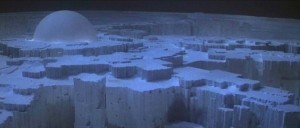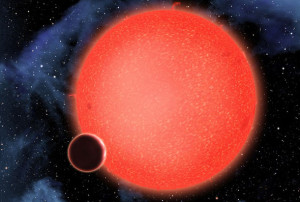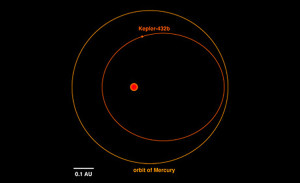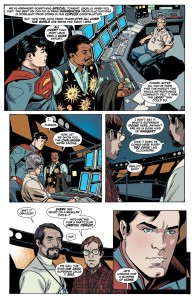A doomed planet orbiting a red giant star that takes 52 days to complete an orbit.
Is this a DC Comics marketing stunt?
This time it’s not called Krypton, and we’re not talking about Superman. It’s called Kepler-432b. It’s about 3,000 light years away from earth and was discovered independently by two teams of astronomers in Germany. The planet is a gas giant with six times the mass of Jupiter, but just about the same size. As a result (increase mass while keeping volume the same) the density of Kepler-432b is about as dense as earth.
432-b was first spotted when NASA’s Kepler space telescope observed small decreases in its parent star’s light. The decrease in light from the star are extremely small, but observable, and it’s one of the methods astronomers use to locate exoplanets. The decrease in light was caused by the planet passing between its sun and Kepler’s “eye,” – a method of location called the transit method. The transit method can only be used to locate planets whose orbits are parallel to that of earth.
Kepler 432-b’s existence was confirmed using the radial velocity method, a measure of how much the star wobbles as the planet and its star orbit around their common center of mass. The star’s wobble is measured with spectroscopy which can reveal if the star is moving toward or away from the earth. The light from a star moving toward Earth will be shifted towards the higher frequency, blue end of the visible light spectrum, while the light from a star moving away from the earth will be shifted toward the lower frequency, red end of the visible light spectrum. The radial velocity method depends upon the mass of the star and the planet, so this method allows the planet’s mass to be calculated.
The host star of Kepler-432b is a red giant, a star that’s entering the end of its lifespan. 432-b’s star is larger than our sun and expanding, due to it having used up its core’s hydrogen, and is now burning hotter as it scavenges all remaining hydrogen from its interior. The heat and pressure of the hotter-burning red giant are enough to overcome some of the core’s gravity, allowing the outer layers of the star to reach outward. Planets too close to red giants are blasted by the energy of the expanding sun before being engulfed by its outer layers.
One thing to remember about red giants is that even though they are bigger, and their cores are burning hotter, that energy is being released over a larger surface area, so ultimately, the star is cooler than it used to be. On the temperature scale, red is cool. Red giants are, therefore, cooler stars than say, our own sun.
Things sound bad, but they’re going to get worse for Kepler-432b. Speaking to the website Sen.com, one of the star’s co-discoverers, Dr. Davide Gandolfi explained that Kepler-432b’s orbit is highly eccentric (the more eccentric an orbit is, the further away it is from a perfect circle), meaning that, at its closest, 432-b is only 15 million miles from its star, before swinging out to a distance nearly 45 million miles away.
“This creates enormous temperature differences over the course of the planet’s year, which is equivalent to 52 Earth days” Gandolfi told Sen. As a result of the differences in distance, over the course of a year, Kepler-432b’s temperatures can change from 500° Celsius (in “winter”) to over 1,000° Celsius (in “summer”) – roughly 932° Fahrenheit to 1832° Fahrenheit.
Oh, but it gets worse. As Phil Plait points out, as the star gets bigger, the interaction between the sun and Kepler-432b will decrease the size of the planet’s orbit until there’s a very good chance 432-b will fall into its star.
Any life forms that may exist on that planet might want to get busy building rockets for their babies to send them to more habitable planets…perhaps those orbiting yellow stars.
Two “by the ways…” here.
1) Yeah – okay, this isn’t where Krypton is supposed to be. In current DC Comics’ continuity, no less than Neil deGrasse Tyson himself identified Krypton’s host star, “Rao,” as being LHS 2520, a real red dwarf star 27.1 light years away from Earth, located at right ascension 12 hours, 10 minutes, 5.6 seconds, and declination -15 degrees, 4 minutes, 15.66 seconds. You can find it…or near it. And Tyson himself now exists in DC Comics’ continuity – from Action Comics #14:
2) This isn’t the first time exoplanets discoveries have seen similarities with fiction, and certainly won’t be the last. Back in 2012, a planet (named PH1) was spotted orbiting a binary star system, leading everyone to make comparisons with Star Wars’ Tatooine. However, like Kepler-432b, PH1 is a gas giant, slightly larger than Neptune. Not saying that life isn’t tough on Tatooine, but life would be a lot tougher living on a planet larger than Neptune.
More:










